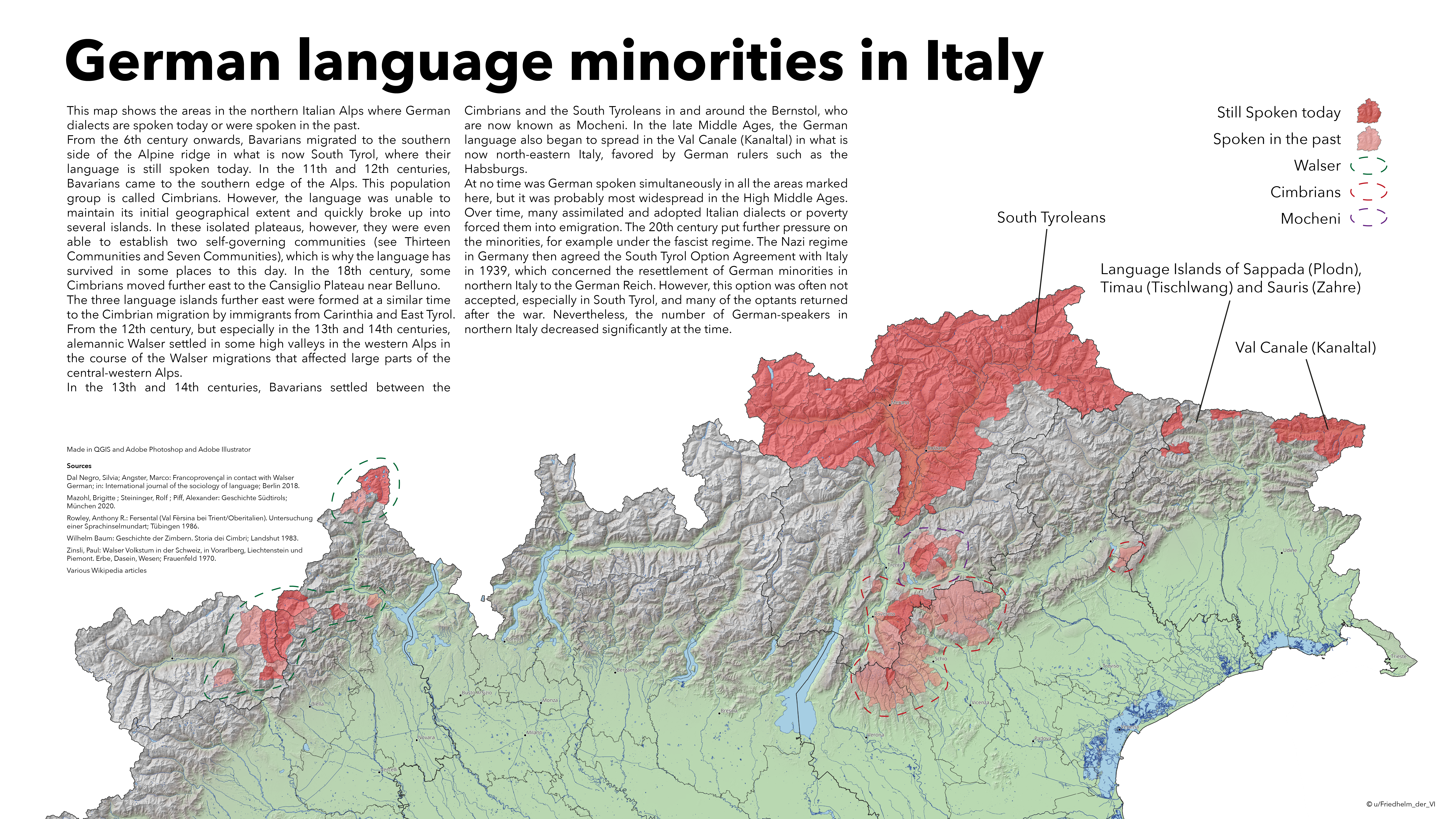German Language Minorities in Italy Map


Alex Cartwright
Senior Cartographer & GIS Specialist
Alex Cartwright is a renowned cartographer and geographic information systems specialist with over 15 years of experience in spatial analysis and data...
Geographic Analysis
What This Map Shows
This map illustrates the distribution of German language minorities in Italy, focusing primarily on the regions where German is spoken as a first language. The visualization highlights areas such as South Tyrol (Alto Adige), where the German-speaking population is notably significant. This region, nestled in the northern part of the country, near the Austrian border, showcases a unique cultural and linguistic identity that sets it apart from the predominantly Italian-speaking areas of Italy.
Deep Dive into German Language Minorities in Italy
The presence of German language minorities in Italy can be traced back to historical migrations and border changes, particularly after World War I when South Tyrol was annexed from Austria to Italy. Today, about 70% of South Tyrol's residents speak German as their first language, creating a vibrant bilingual community where both Italian and German co-exist.
Interestingly, the coexistence of these two languages has led to a rich cultural tapestry, including festivals, literature, and education that reflect both Italian and German influences. The region's cultural heritage is celebrated through events like the South Tyrolean Wine Road festival, where local German-speaking vintners showcase their products alongside their Italian counterparts.
Statistically, the German-speaking population in South Tyrol is approximately 300,000 people, which is substantial given the region's total population of around 520,000. This demographic concentration has resulted in several municipalities where German is the primary language of administration, education, and media. For instance, in Bolzano, the provincial capital, bilingual signs are commonplace, and schools offer instruction in both languages.
However, the dynamics of language use are not static. The younger generation in South Tyrol is increasingly bilingual, often switching between Italian and German based on context and social settings. This linguistic fluidity reflects broader trends in globalization, where language is not just a means of communication but also a marker of identity.
Moreover, the situation of German speakers extends beyond South Tyrol, as small groups can also be found in the neighboring Trentino region and even in parts of the Aosta Valley. These communities, though smaller, also maintain their language and cultural practices, contributing to the overall linguistic diversity of Italy.
Regional Analysis
Focusing on South Tyrol, it's essential to explore how the German-speaking population interacts with the Italian-speaking majority. The province is divided into several districts, with Bolzano being the most urbanized and linguistically diverse. Here, German speakers make up about 75% of the population, while Italian speakers account for around 25%. In contrast, in more rural areas like the Val Venosta, the percentage of German speakers can rise to as high as 90%.
Interestingly, cultural integration is most visible in urban settings where both languages are utilized in schools and public services. However, in more isolated villages, the German language remains dominant, preserving traditional customs and dialects. For example, the village of Ortisei in the Val Gardena is renowned for its German-speaking population and also serves as a tourist hotspot, attracting visitors with its unique blend of Alpine culture and Italian hospitality.
Significance and Impact
Understanding the German language minorities in Italy is crucial for several reasons. First, it emphasizes the importance of linguistic diversity within Europe and highlights how historical events shape modern demographics. The coexistence of German-speaking communities enriches Italy's cultural landscape, fostering a sense of identity and belonging among residents.
Moreover, the recognition and protection of language rights for minorities can have broader implications for social cohesion and political stability. In South Tyrol, for example, the autonomy granted to the region allows for the preservation of the German language and culture, which has been essential for maintaining peace between different linguistic groups.
Looking ahead, it will be interesting to observe how globalization and migration trends will affect these communities. As younger generations become more integrated into global culture, will the German language maintain its prominence, or will we see shifts towards greater Italianization? This question remains open-ended, but the resilience of the German-speaking population in Italy provides a strong foundation for the future.
In conclusion, the map of German language minorities in Italy not only highlights geographical distribution but also serves as a reminder of the rich cultural narratives that shape our world today. It invites us to appreciate the complexities of identity, language, and community in an ever-evolving society.
Visualization Details
- Published
- August 8, 2025
- Views
- 126
Comments
Loading comments...